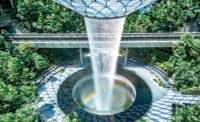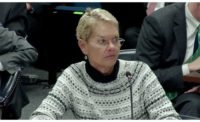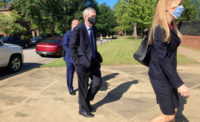South Carolina politicians investigating the failed V.C. Summer nuclear expansion would do well to focus on Westinghouse Electric Co.’s “unbuildable” design for its AP1000 nuclear reactors, people who worked on the project told ENR. Starting from the company’s previous Advanced Passive (AP) 600 design—rated at 600 MW per unit—engineers developed the new, 1100-MW AP1000 design based on the 600’s old footprint. That proved to be a “mistake,” says a former V.C. Summer construction manager who spoke to ENR on the condition of anonymity.
Attempting to fit a more powerful design into a similar footprint “ate up all their margin [for error],” contends the source. “Any construction project is doomed to fail when it has no margin for changes, and new change papers were getting written every day.”
Design problems became evident almost immediately, when the modular construction units being assembled at the Shaw Group’s Lake Charles, La., facility—which proved to be one of the more problematic fabrication sites—arrived at the project site with issues ranging from shoddy welds to off-spec tolerances. When Shaw Group used other vendors to perform the work, more difficulties arose, from complicated, global supply-chain issues to delayed arrivals, expired materials, wasted time and repeated design busts due to the low margin for error, the source said.
The other vendors’ work “would have to be examined for mistakes, then re-done, then have those changes approved, then try to work the units into a location where there wasn’t enough room designed for them,” the former construction manager says. “Specifications couldn’t be off by an inch here or a pound of pressure there.”
The design busts weren’t limited to mistakes related to the complex engineering of outsized reactor modules, either.
“We’d get a design for an operator to press a button that was too high for someone to reach,” says a 31-year-old senior nuclear operator candidate who had been training at the site from June 2014. The source, who lost his job last month when project owners South Carolina Electric and Gas Co. (SCE&G) and Santee Cooper announced they were abandoning the project, spoke on condition of anonymity over concern of reprisals as he looks for new work.
Those problems began a cycle of spiraling delays and escalating costs as laborers would tear down and redo portions of prefabricated units according to specifications that changed almost daily, then often remain idle for days and weeks as new change orders waited for approval.
“We had to tear up more rebar and throw away more steel than any project I’ve ever been on,” says Ken Oxendine, a rod buster with more than 25 years of experience. “Waste because of the changes was like nothing I’ve seen, but the attitude was that the project had unlimited money. So as long as everyone was getting paid, it was somebody else’s problem.”
Responding to ENR via email, Westinghouse defended its design for the V.C. Summer project.
“The AP1000 standard plant has been designed with significant margins with respect to nuclear safety, seismic design, external hazards and human dependencies,” the company’s statement noted. “The nuclear safety margins are realized through a thorough design analysis and testing program carried on throughout the development of the AP600 and the AP1000.”
Implementation of the testing program at the Sanmen and Haiyang projects in China produced “excellent results” that “further demonstrate the robustness of the design margin included in the AP1000 passive safety systems,” the statement added.
On July 31, an estimated 5,000 employees lost their jobs when SCE&G and Santee Cooper announced their decision to abandon the project.
“I was looking forward to working there my whole career,” said the senior nuclear operator candidate. “I was going to build a life around that plant and so were a lot of other people.”





Post a comment to this article
Report Abusive Comment